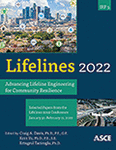Applying Consequence-Driven Scenario Selection to Lifelines
Publication: Lifelines 2022
ABSTRACT
We present a new consequence-driven framework for earthquake scenario selection. For emergency managers, utility operators, policy makers, and other stakeholders, a scenario-based seismic risk assessment is often necessary for the purpose of emergency management and planning. In developing a scientifically defensible scenario, stakeholders can simulate a realistic event in order to pre-identify vulnerabilities in the system and support action to address these vulnerabilities. Selecting scenarios is particularly challenging for important population centers and critical infrastructure in stable tectonic environments, such as in the central and eastern United States, where uncertain long-term seismicity and unknown faults offer inadequate constraints. Notably, significant events in these so-called stable regions do occur (e.g., Nahanni, Canada, 1985, M6.9; Tennant Creek, Australia, 1998, M6.7). In regions of low seismicity, even moderate events can be consequential due to the higher vulnerability of buildings typical of such regions when compared to regions of higher seismicity. Furthermore, communicating seismic risk to stakeholders and the general public in these regions can be especially challenging due to the complexities of characterizing the hazard level. This framework has been developed to address these challenges for scenario selection in low seismic hazard regions. In this new approach, the analysis begins instead with the explicit definition of a consequence of concern to the specific stakeholder. This can range from a definition of loss (in lives, dollars, or another metric of interest), or a performance metric for critical infrastructure. The framework leverages United States Geological Survey software to run the hazard and consequence analysis. Driven by this stakeholder-defined consequence, an inversion analysis generates a complete event set of candidate scenarios that could breach this consequence. The final selection of a scenario, or family of scenarios, is then scientifically informed, but not limited by our lack of constraints in characterizing the hazard.
Get full access to this article
View all available purchase options and get full access to this chapter.
REFERENCES
Allen, T. I. (2019). “Seismic hazard estimation in stable continental regions: Challenges and opportunities.” 2019 Pacific Conference on Earthquake Engineering and Annual NZSEE Conference, 17.
Amer, M., Daim, T. U., and Jetter, A. (2013). “A review of scenario planning.” Futures, 46, 23–40.
Baker, J. W., and Cornell, C. A. (2008). “Uncertainty propagation in probabilistic seismic loss estimation.” Structural Safety, 30(3), 236–252.
Basoz, N., and Mander, J. (1999). Enhancement of the Highway Transportation Lifeline Module in Hazus. National Institute of Building Sciences.
Cornell, C. A. (1968). “Engineering seismic risk analysis.” Bulletin of the Seismological Society of America, 58(5), 1583–1606.
Cousins, W. J., Power, W. L., Destegul, U. Z., King, A., Trevethick, R., Blong, R., Weir, B., and Miliauskas, B. (2009). “Earthquake and tsunami losses from major earthquakes affecting the Wellington region.” Conference of the New Zealand Society for Earthquake Engineering, 3–5.
Detweiler, S. T., and Wein, A. M. (2017). “The HayWired earthquake scenario”.
Ebel, J. E., and Kafka, A. L. (1999). “A Monte Carlo approach to seismic hazard analysis.” Bulletin of the Seismological Society of America, 89(4), 854–866.
FHWA (Federal Highway Administration). (2019). National Bridge Inventory. US Department of Transportation.
FEMA. (2013). Technical Manual HAZUS-MH 2.1: Earthquake Model. Washington, D.C.
Ghosh, J., and Padgett, J. E. (2011). “Probabilistic seismic loss assessment of aging bridges using a component-level cost estimation approach.” Earthquake Engineering & Structural Dynamics, Wiley Online Library, 40(15), 1743–1761.
Greene, M., Wong, I., Tubbesing, S., and Lemersal, E. (2010). “Promoting the development and uses of earthquake scenarios.” Proceedings of the 9th U.S. National and 10th Canadian Conference on Earthquake Engineering.
Jones, L. M. (2020). “Empowering the public with earthquake science.” Nature Reviews Earth & Environment, 1(1), 2–3.
Lin, K.-W., Wald, D. J., and Turner, L. L. (2009). “Using ShakeCast and ShakeMap for Lifeline Post-Earthquake Response and Earthquake Scenario Planning.” TCLEE 2009, American Society of Civil Engineers, Oakland, California, United States, 1–12.
Lin, Y. C., Jenkins, S. F., Chow, J. R., Biass, S., Woo, G., and Lallemant, D. (2020). “Modeling downward counterfactual events: Unrealized disasters and why they matter.” Frontiers in Earth Science, 8, 575048.
Petersen, M. D., Mueller, C. S., Moschetti, M. P., Hoover, S. M., Llenos, A. L., Ellsworth, W. L., Michael, A. J., Rubinstein, J. L., McGarr, A. F., and Rukstales, K. S. (2016). “Seismic‐hazard forecast for 2016 including induced and natural earthquakes in the central and eastern United States.” Seismological Research Letters, 87(6), 1327–1341.
Preuss, J., and Godfrey, J. (2006). Guidelines for developing an earthquake scenario. Earthquake Engineering Research Institute.
Schulte, S. M., and Mooney, W. D. (2005). “An updated global earthquake catalogue for stable continental regions: reassessing the correlation with ancient rifts.” Geophysical Journal International, 161(3), 707–721.
USGS. (2020). “Unified hazard tool.” U.S. Geological Survey, <https://earthquake.usgs.gov/hazards/interactive/>(May 25, 2020).
Wilkinson, A., Kupers, R., and Mangalagiu, D. (2013). “How plausibility-based scenario practices are grappling with complexity to appreciate and address 21st century challenges.” Technological Forecasting and Social Change, 80(4), 699–710.
Wong, I., Bouabid, J., Graf, W., Huyck, C., Porush, A., Silva, W., Siegel, T., Bureau, G., Eguchi, R., and Knight, J. (2005). “Potential losses in a repeat of the 1886 Charleston, South Carolina, earthquake.” Earthquake Spectra, 21(4), 1157–1184.
Woo, G. (2019). “Downward counterfactual search for extreme events.” Frontiers in Earth Science, 7, 340.
Worden, C. B., Thompson, E. M., Hearne, M., and Wald, D. J. (2020). “ShakeMap Manual Online: Technical manual, user’s guide, and software guide.” U. S. Geological Survey, <http://usgs.github.io/shakemap/>(May 25, 2020).
Wyss, M. (2005). “Human losses expected in Himalayan earthquakes.” Natural Hazards, 34(3), 305–314.
Information & Authors
Information
Published In
History
Published online: Nov 16, 2022
Authors
Metrics & Citations
Metrics
Citations
Download citation
If you have the appropriate software installed, you can download article citation data to the citation manager of your choice. Simply select your manager software from the list below and click Download.
